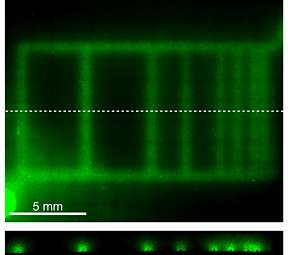Researchers create system to build transplant tissue

One day soon, laboratories may grow synthetically engineered tissues such as muscle or cartilage needed for transplants. In a major step forward, Cornell engineers describe in the journal Nature Materials a microvascular system they have developed that can nourish growing tissues.
The researchers have engineered tiny channels within a water-based gel that mimic a vascular system at the cellular scale and can supply oxygen, essential nutrients and growth factors to feed individual cells. The so-called gel scaffold can hold tens of millions of living cells per milliliter in a 3-D arrangement, such as in the shape of a knee meniscus, to create a template for tissue to form.
In theory, the system could accommodate many kinds of tissue.
"A significant impediment to building engineered tissues is that you can't feed the core," said Abraham Stroock, Cornell assistant professor of chemical and biomolecular engineering and one of the paper's senior authors. "Simply embedding this mimic of a microvascular system allows you to maintain the core of the tissue during culture." Gel scaffolds, he said, "are the culture flasks of the future."
The embedded microchannels allow fluid with oxygen, sugar and proteins to travel through the system. The researchers can control the distributions of these solutes over both time and space within the developing tissue, allowing the fine-tuning of the biochemical environment of the cells while the tissue develops. For example, the tissue may need to develop into bone on one side and cartilage on the other. Now the researchers can supply the right nutrients and proteins to certain parts of the growing tissue to ensure an intended outcome.
The research provides solutions to the physical engineering aspects of growing tissues synthetically. Still, many biological challenges remain, such as finding a source of cells that can be harvested from a patient and grown without changing the cell's characteristics. Co-author Lawrence Bonassar, a Cornell associate professor of biomedical engineering who was instrumental in developing the gel for tissue growth and in determining the proper biological requirements for cell growth, is also among those trying to direct stem cells to produce desired tissue types. Currently, stem cell-derived cartilage has been made but is not functional.
As new tools develop, researchers hope to use these engineered tissues in non-clinical applications, such as replacements for animals in the testing of pharmaceuticals and chemicals. The technology, researchers believe, also offers the hope of growing implants from the patient's own cells to replace damaged or diseased tissue.
Source: Cornell University
















